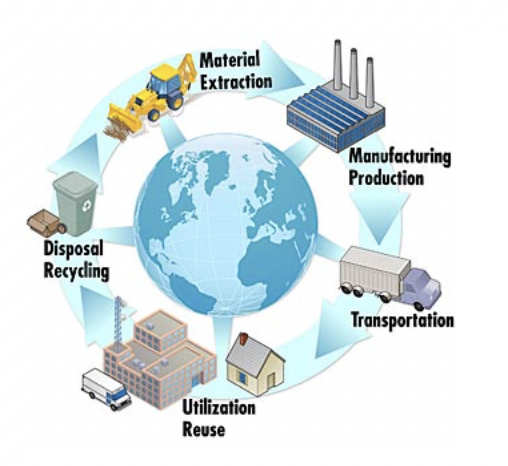Life-Cycle Assessment (LCA)
New CommercialWhat is Life Cycle Assessment?
A life cycle assessment (LCA) is a “cradle-to-grave” or “cradle-to-cradle” evaluation method that assesses the environmental impacts of products, processes, and services.[1] In the commercial building sector, LCA is a tool that helps architects and building professionals understand the embodied energy and other environmental impacts associated with all life cycle phases of a building or building product as defined by the ISO 14040/44 standard including resource extraction, manufacturing, transportation, construction, operation, and disposal or recycling (see Figure 1).[2] The evaluation at each phase also includes the associated activities of a particular building product or design. For example, during the operational phase, the LCA for a deck includes the impact of the resources used for cleaning (e.g., energy, water, detergents), staining, or replacing boards.[3]

Figure 1. LCA Phases (Source: NIST Sustainable Manufacturing Program)
Defined environmental impact areas commonly include: [4]
- Climate change (“carbon footprint”)
- Acidification (“acid rain”)
- Eutrophication (“algal bloom”)
- Photochemical oxidant creation (“summer smog”)
- Ozone depletion (“the ozone hole”)
LCA’s support informed decision-making by providing a standardized system for verifying environmental footprints and claims, identifying environmental trade-offs, and making relative comparisons between different design paths or product choices.
While LCA’s take into account environmental impacts, Life Cycle Cost Analysis (LCCA) evaluates the life-cycle costs of building designs and systems (see Life Cycle Cost Analysis (LCCA)). Together, LCA’s and LCCA’s provide the essential components of a comprehensive cost-benefit analysis.
How to Implement Life Cycle Assessment (LCA)
Increasingly, consumers and regulatory agencies are asking businesses and product manufacturers to provide environmental product declarations, which use LCA data to report the environmental impacts of their products, processes, and services (see Sustainable Materials). In the building sector, green building programs such as LEED, offer credits for completing a whole building LCA as part of the integrated design process.[5] LEED credits are also offered to promote the reuse of historic buildings and the renovation of abandoned or blighted buildings.[6] Likewise, the field of LCA continues to evolve as the quality and completeness of LCA data improves and LCA methodologies are tested and refined.
The complete process of LCA includes:[7]
- Defining goals and assessment boundaries.
- Collecting information on materials and design alternative.
- Using accredited LCA assessment tools to perform impact calculations.
- Compiling and interpreting results.
- Documenting the process and providing assessment reports.
LCA reports are often complex and technical in nature, but current tools attempt to summarize LCA information in a manageable format specifically targeted to design professionals. Tools are available for both whole building and product level LCA’s.
Athena EcoCalculator is a free online LCA calculator that provides a streamlined report of building’s footprint using LCA data on hundreds of common building products.
Athena Impact Estimator for Buildings is a free LCA-based software package for designers and building professionals that provides environmental impact data on over 1,000 structural and envelope assembly combinations.
Building for Economic and Environmental Software (BEES) is a free online tool for selecting cost-effective and environmentally preferable building products and includes actual environmental and economic performance data for 200+ building products.
Benefits
The main benefit to LCA is credible, transparent data that informs greener design and product decisions and the associated cost savings and environmental benefits from reduced resource consumption, pollution, and waste.
Costs
The costs for performing an LCA depend on the scope and complexity of the building project, data availability and on whether in-house expertise or an independent consulting service completes the analysis. Several free online tools and resources are available to help owners and designers perform LCA’s (see Resources). Costs for performing an LCA typically include labor costs for data collection and data input and the interpretation and reporting of results.
Resiliency
An LCA can identify and evaluate the environmental benefits of green building designs and products that enhance building resiliency. These may include specific design inputs for address increasing heat, more intense precipitation, or rising sea levels. For example, resilient strategies may include cooling and shading features (e.g., cool pavements and cool roofs), improving the efficiency of building envelopes (e.g., insulation, windows, exterior walls), planning for increased failure or reduced efficiency of electrical or mechanical systems (e.g., battery storage), and providing passive solar cooling and ventilation features (e.g., Properly-Sized HVAC systems).[8] LCA’s focused on resilient design can also consider the avoided costs or resiliency benefits of avoided power outages, such as reduced business closures, health, and safety hazards, food spoilage, and inconvenience from schedule disruptions. [9]
[1] National Renewable Energy Laboratory (NREL). Life Cycle Assessments – U.S. Life Cycle Inventory Database. https://www.nrel.gov/lci/assessments.html (accessed January 30, 2019).
[2] International Standard for Standardization (ISO). ISO14040 Standard (2006) provides LCA principles and framework; https://www.iso.org/standard/37456.html (accessed January 30, 2019); ISO 14044 Standard (2006) provides LCA Requirements and Guidelines. https://www.iso.org/standard/38498.html (accessed January 30, 2019).
[3] Athena Sustainable Materials Institute. 2018. About LCA.
http://www.athenasmi.org/wp-content/uploads/2012/01/LCA_summary_of_four_pages.pdf (accessed January 30, 2019).
[4] Rajesh Kumar Singh. 2017. “Whole Building Life Cycle Assessment Through LEED v4.” GBCI
http://www.gbci.org/whole-building-life-cycle-assessment-through-leed-v4 (accessed January 28, 2019).
[5] USGBC LEED Version 4.1 BD+C Beta. 2019. Building Life-cycle Impact Reduction https://new.usgbc.org/leed-v41 (accessed January 30, 2019).
[6] Ibid USGBC LEED Version 4.1 BD+C.
[7] Ibid USGBC LEED Version 4.1 BD+C.
[8] NYC Mayor’s Office of Recovery and Resiliency. April 2018. Climate Resiliency Design Guidelines. Version 2.0. Page 9-19. http://www1.nyc.gov/assets/orr/pdf/NYC_Climate_Resiliency_Design_Guidelines_v2-0.pdf (accessed June 11, 2018).
[9] DOE. “Smart Grid Investments Improve Grid Reliability, Resilience, and Storm Responses.” https://www.smartgrid.gov/files/B2-Master-File-with-edits_120114.pdf (accessed May 1, 2018).
